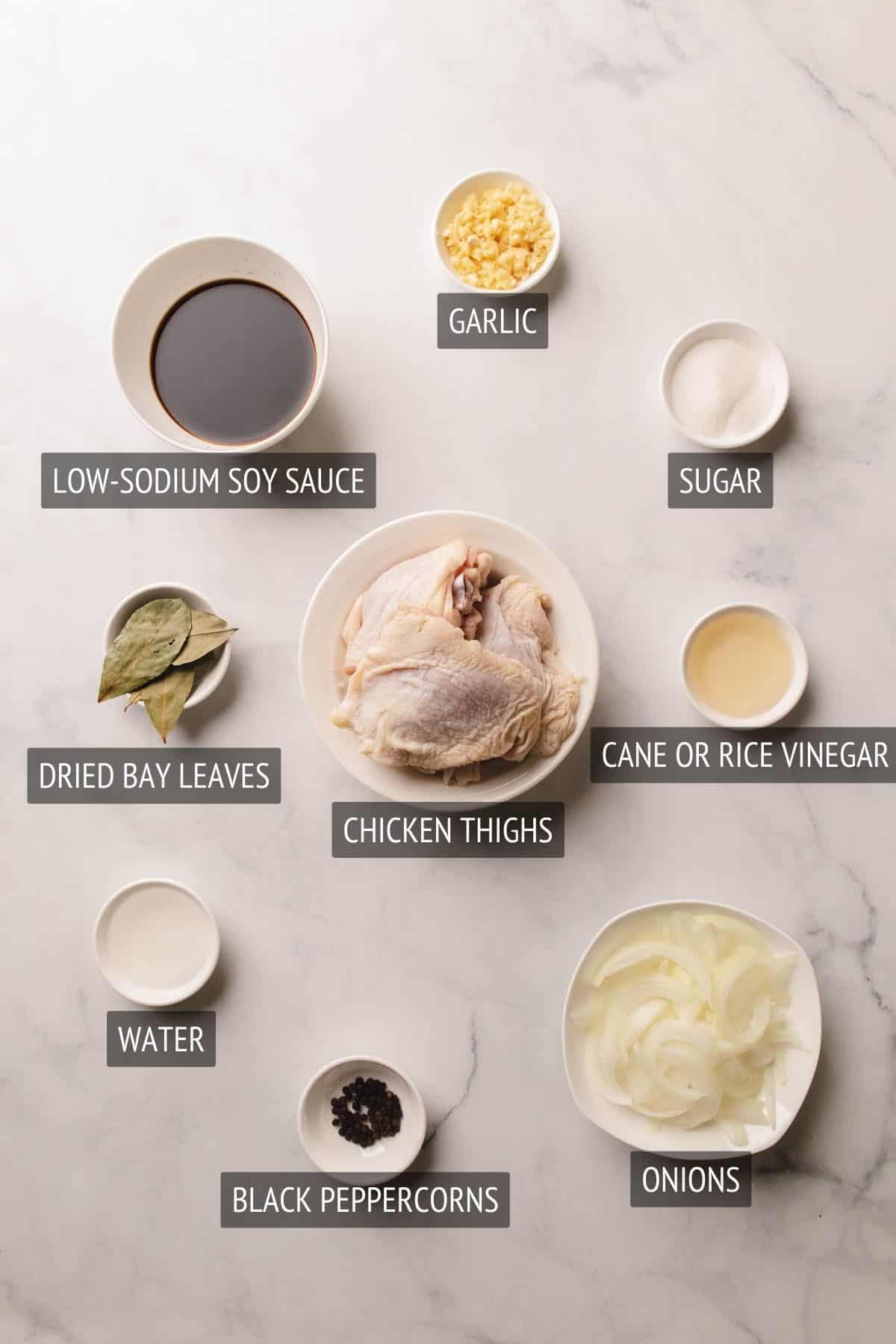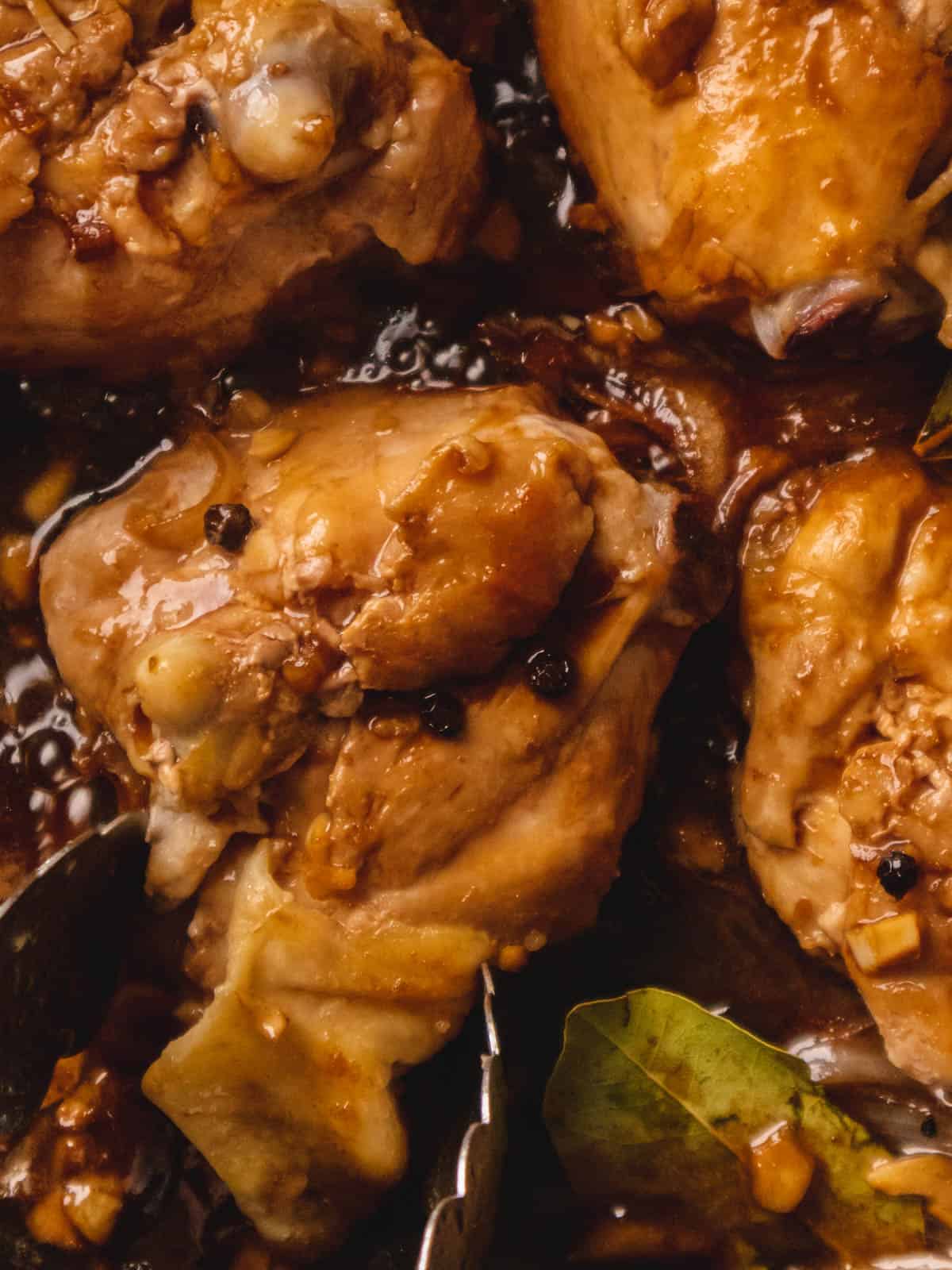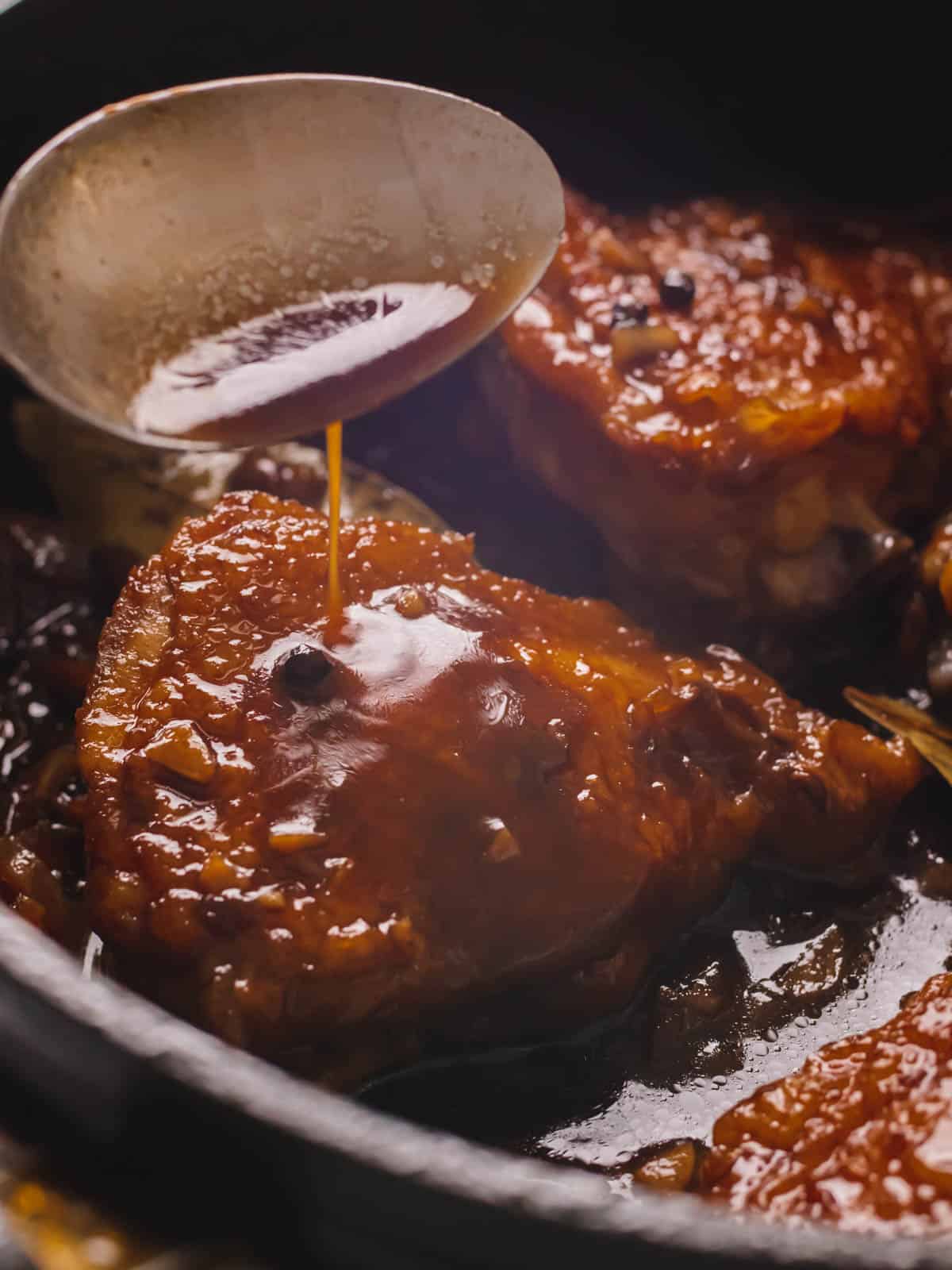Make a SUPER flavorful & budget-friendly 30-minute meal you know everyone will love! This easy Adobong Manok, or Filipino Chicken Adobo, transforms simple pantry staples into a mouthwatering meal – with minimal dishes left behind! Weeknight dinners will never be the same 🙂

Chicken Adobo, or Adobo Manok, is a classic and lovable Filipino dish that’s INCREDIBLY easy to make. My mom made it a point that my sister and I knew how to make it when we were kids using pantry ingredients. SO, if 10-year-old Mikha can make it, you 1,000% got this!
There are probably as many versions of Filipino Adobo as there are mothers in the world, and this quick version of Chicken Adobo inspired by how I grew up eating it. My single mom of two didn’t have time to marinate chicken, so she figured out how to create the BEST flavor – even without marinating 🙂
If you want to make a Filipino feast, don’t sleep on Miso Salmon Sinigang, Sinigang na Baboy, or a comforting bowl of Chicken Arroz Caldo. These are the simple Filipino dishes that feed the soul.
❤️ Highlights
🍗 What is Chicken Adobo (Adobong Manok)?
Adobong Manok, or Chicken Adobo, is the national dish of the Philippines using the methods of marinating then braising. When Spanish colonizers saw this marinating method, the dish was labeled ‘adobo de los naturales’ – adobo of the natives. The name stuck and every region has their own nuance to the dish.
There are SO many variations of Filipino Adobo, but two main ingredients are soy sauce and vinegar.
Back in the day (before refrigerators & freezers), vinegar and salt helped preserve meat in the Philippines instead of spoiling from the hot tropical weather. Thanks to Chinese trade, soy sauce was eventually used and is now one of the most important ingredient in Adobong Manok!
Soy sauce gives the dish a salty savory flavor and the vinegar adds tangy that balances the saltiness from the soy sauce. And as the sauce thickens… oooo that’s the best part! The glossy syrupy sauce turns into a deep rich color that begs to be poured over the chicken and soaked up on hot steamy rice!
If you have any leftover Chicken Adobo or its sauce, don’t you dare throw it away – that is liquid gold! Transform it into a quick Adobo Fried Rice and Tortang Talong, then BOOM – you have another full meal for breakfast!
That’s Filipino resourcefulness for you 😉
🥘 Ingredients
Chicken Adobo is the perfect last-minute meal because you probably already have everything you need in your kitchen. Annnd, you can feel confident that everyone’s going to love it!

- Chicken: I’m using boneless skinless chicken thighs for this Adobong Manok recipe because it cooks up super quickly & is a healthy lean option. If you use bone-in skin-on chicken thighs, you’re treating yo’ self to an extra flavorful Chicken Adobo *yumm*! Just keep in mind , it’ll take slightly longer to finish cooking.
- Low-Sodium Soy Sauce: Typically, regular soy sauce (such as the Filipino Silver Swan Soy Sauce) is used for classic Chicken Adobo. However, I like the sauce a thicker consistency. To avoid it being too salty, low-sodium soy sauce is a better fit for this recipe. If you use regular soy sauce, you may need to add a little more water.
- Cane Vinegar or Rice Vinegar: Cane vinegar is traditionally used for Chicken Adobo & less sharp than white vinegar. *Don’t freak out if you don’t have it!* Rice vinegar is an easy substitute.
- Dried Bay Leaves: Chicken Adobo doesn’t taste the same without this simple ingredient! The bay leaf is an absolute must that adds a warmth of flavor.
- Onions: This may not be considered traditional ingredient, but this is how my mom made it growing up! And honestly, it’s hard to imagine making Chicken Adobo without those caramelized onions *shrug* 😉
- Sugar: A little sugar balance the sourness from the vinegar & saltiness of the soy sauce. The result is this irresistible glossy & syrupy sauce to drench your juicy chicken & steamy rice!
- Black Pepper: This is a key ingredient that adds a peppery bite to this delicious Filipino dish!
See recipe card for quantities.
📖 Substitutions
- Vinegar: Rice vinegar is an easy alternative to cane vinegar because it’s similarly mellow in acidity. White distilled vinegar is much sharper sourness, which works if you like more tang in your Adobo Manok.
- Black Peppercorns vs Cracked Pepper: Black peppercorns are typically used in Adobo Manok, but cracked black pepper also works! This is especially helpful if you have kids (or a husband who’s a giant kid *ahem* lol) that don’t like that peppery bite.
📖 Variations
As I mentioned before, there are SO many ways to make variations of adobo – it’s really versatile. This easy Chicken Adobo recipe is one of the most common versions, however, various regions of the Philippines and families have their own twist!
Here are some variations and substitutions you can play around with:
- Marinated Version: Marinating chicken is the traditional method of making Chicken Adobo. If you have the extra time, it makes the chicken even more flavorful! Combine the sauce ingredients (except for the bay leaves and onions), then add the chicken pieces, cover, & marinate for at least 2 hours in the fridge. Pat dry well to get a nice sear, then follow the directions in the recipe below. Use the marinade for the adobo sauce.
- Coconut Milk: A splash of coconut milk (aka Adobong Manok Gata) adds a layer of richness and creaminess with a subtle coconut flavor.
- Pineapple: Pineapple chunks or slices is another version that makes the dish fresh and bright. It can also help cut through the richness of fatty meats, like pork or skin-on chicken.
- Hard-Boiled Eggs: Eggs add a cheap and easy way to pack in more protein. Add peeled hard boiled eggs the last few minutes of cooking. They’ll soak up some of that delicious sauce without being overcooked.
- Pork Adobo: Cooking with pork is mouthwateringly rich, fatty, and (let’s be honest) extra yummy. My family usually used pork belly and it ALWAYS hit the spot for a super rich version of adobo. Asian soul food at its finest!
- Vegetarian: If you’re looking for a way to spice up eating your veggies, try cooking it as Filipino Adobo! This is what I did when I was pescatarian and it was SO good! You can use string beans, kangkong (water spinach), or even shishito peppers.
🔪 Instructions
This one-pot Filipino Adobo is such a weeknight lifesaver because it means less dishes and creates maximum flavaaa with minimal effort. Here’s the simple cooking process of how to cook Adobong Manok in under 30 minutes!

Step 1: Heat a large pot or deep pan on medium-high heat with a little oil. Add the chicken flat-side down and sear for a couple minutes, or until golden brown – but not cooked through. They’ll finish cooking in the umami adobo sauce!

Step 2: Remove chicken, add a little more oil if needed, then toss in the onions. Sautee for a few seconds, or until they begin to soften but are still crunchy. Add the garlic and sauté for a few more seconds, or until soft and fragrant.

Step 3: Add the chicken back in flat-side down. Pour in soy sauce along the edges to develop a slight char, then add sugar, vinegar, bay leaves, & black pepper.
Bring to a rolling boil, then reduce to medium low heat. Simmer uncovered for about 15 minutes, or until the chicken is cooked, flipping about halfway through.

Step 4: Once done, chicken should be cooked through & sauce will be glossy and syrupy. If the sauce isn’t your desired consistency, see “Key Tips” section below, I gotchu 😉 Garnish is green onions if you’re feeling fancy & serve with fresh steamy white rice. Enjoy!

👩🏽🍳 Key Tips
- Quickest Way to Create Extra Flavor: Searing meat before adding any sauce or broth adds an extra layer of flavor and color. Yes, technically, you can dump all the ingredients in the pan and cook away (I’ve done this plenty of times growing up haha). BUT, the extra minute or two to sear makes a HUGE difference!
- The Importance of Not Stirring: Once you add all your ingredients to the pot, stir the sauce so it’s well combined. Then, let it work its magic without interfering. Stirring in between will make the vinegar take longer to cook and you’ll end up with a sharp vinegar flavor. Or, you’ll have to cook the dish longer & risk dried out chicken thigh. Bleh!
- Adjusting Adobo Sauce Consistency: If the sauce hasn’t thickened up enough to your liking, remove the chicken, increase the heat to medium-high & reduce to your preference. Add chicken back in and coat well in the sauce. Alternatively, if it’s thickened too much or is too salty, you can add a splash of water.
- How Saucy Do You Like It??: I make enough adobo sauce to braise the chicken and coat some steamy white rice. If you love yours extra saucy, (yasss, I don’t blame you bc that sauce is BOMB), double the sauce ingredients!

💭 Recipe FAQs
Let’s get cooking!
Get into my secret stash of Goody-Packed Newsletters with meals planned for you & time-saving tips! Want step-by-step videos of how to make my recipes too? I gotchu over at my youtube channel. Aight, enough chatting, more eating!

Adobong Manok | Easy Chicken Adobo Recipe
Ingredients
- 1 pound chicken thigh*
- 1 small onion thinly sliced
- 7 garlic cloves minced
- 4 dried bay leaves
For Sauce:*
- 1/2 cup light soy sauce
- 1/8 cup rice vinegar
- 1 teaspoon whole black peppercorns*
- 2 tablespoons sugar
- 2 tablespoons water
Instructions
- Heat a pot or skillet on medium-high heat with a little oil, then add chicken thighs skin/flat side down and sear for about 1 minute per side, or until golden brown. The chicken shouldn’t be cooked through! This is just to get some color, then they'll finish braising in the adobo sauce. Remove & set aside.
- Add onions and garlic, then saute for a couple of seconds, or until they’re soft and fragrant.
- Add chicken back in, then pour in soy sauce, rice vinegar, bay leaves, whole black peppercorns, sugar, and water. Stir gently until sugar dissolves, then bring to a rolling boil. Reduce heat to medium-low and cook uncovered for about 20 minutes, flipping chicken halfway through. Cooking time may vary depending on the size, thickness, & type of chicken (bone-in vs boneless). Avoid stirring while cooking so the vinegar cooks.
- Once it’s cooked, the meat is no longer pink at the thickest part & its juices run clear. The sauce should be reduced to a sweet and savory sauce. If the sauce isn’t thickened enough to your liking, remove chicken and reduce sauce further (it’ll reduce much quicker without the chicken). Return chicken to the skillet and coat chicken in the sauce. Serve over steamy hot rice and enjoy!
Notes
- Sauce: The sauce ingredients make a light sauce to coat the chicken with some rice. If you like a very saucy adobo, you can double the sauce ingredients!
- Chicken: Bone-in with skin-on OR boneless & skinless chicken thighs both work well in this recipe because always come out super juicy. Keep in mind, bone-in chicken thighs take slightly longer to cook but is a more flavorful. Boneless & skinless chicken thighs are a great leaner option that saves a little time too.
- Low-Sodium Soy Sauce: Typically, regular soy sauce (such as the Filipino Silver Swan Soy Sauce) is used for classic Chicken Adobo. However, I like a thicker adobo sauce, so I use low-sodium soy sauce so it doesn’t get too salty.
- Cane Vinegar or Rice Vinegar: Cane vinegar is typically used for Chicken Adobo. It’s less sharp than white vinegar. Rice vinegar is an easy substitute.
- Marinating: If you have the extra time, you can marinate the chicken in the soy sauce, vinegar, sugar, & peppercorns for at least 2 hours or up to overnight. Before searing the chicken, pat them dry well so it doesn’t steam in the pan. Use the marinade as the sauce in the recipe.
- Key Tips & Reheating: Check out the blog post above for more key tips & reheating suggestions for a delicious Chicken Adobo!
Nutrition
Exact calculations may vary. For the most accurate nutritional information, use your preferred nutrition calculator, actual ingredients, and quantities used for the recipe. Please consult with your physician or registered dietitian if more precise nutrition calculations are needed for health reasons.











I’m making this recipe tonight for the 3rd time in the last 6 months. I use Silver Swan soy sauce and palm sugar with this recipe. I love how fast this is and the flavor is still amazingly complex.
Aww, I’m so glad you enjoy it, Kyle! Swan soy sauce is classic. I need to try it with palm sugar, that sounds so good. Thanks for sharing!
I am doing it right now, easy recipe. Although I knew adobo has a different of ideas. Thanks for sharing!
Yay! Thanks for sharing, Nidz!